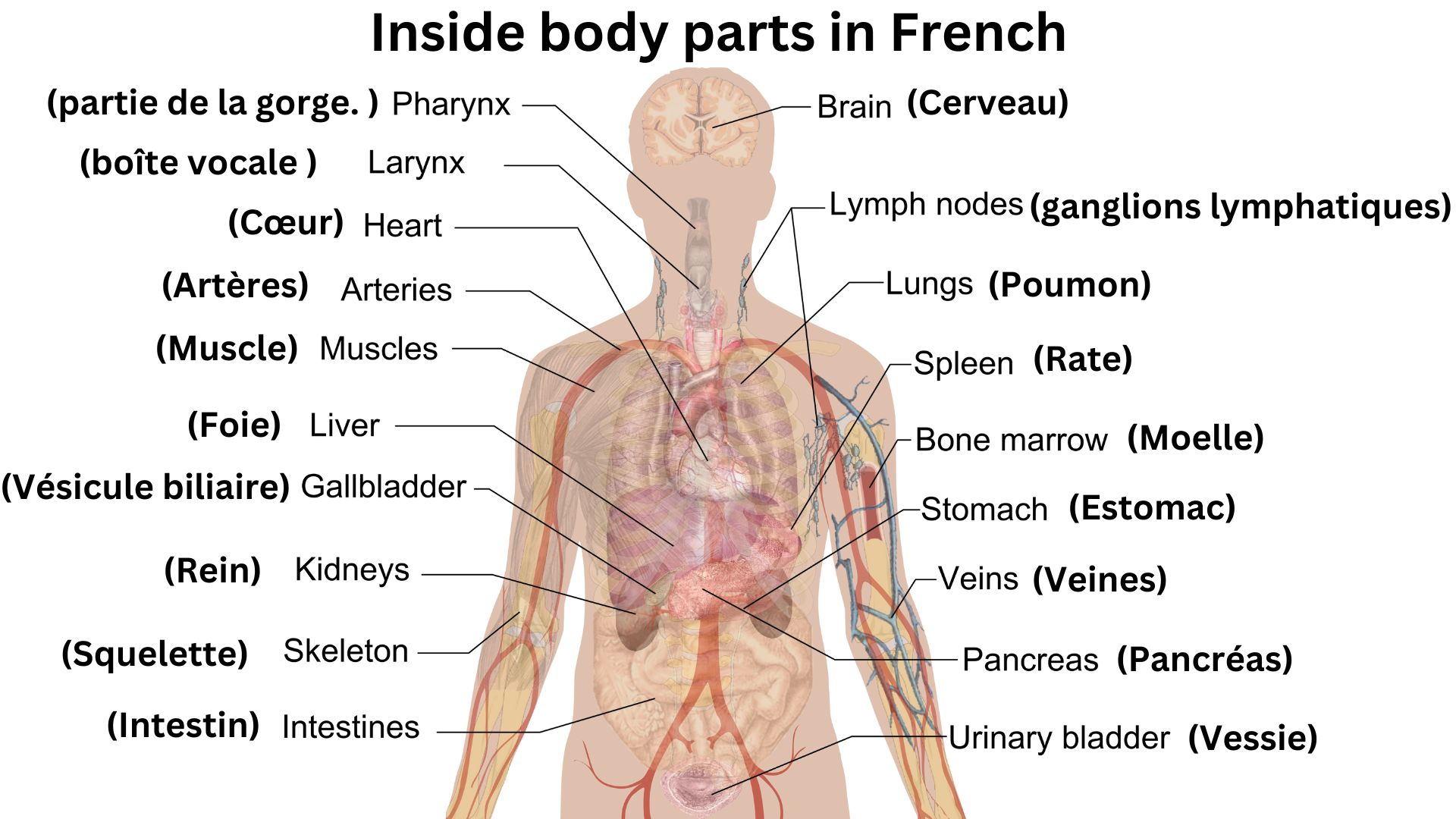Studying French isn’t just for school—it’s also super useful in real life. Whether you’re in a doctor’s office, at the gym, or just talking to someone, knowing body parts in French like ‘la tête’ for head or ‘le torse’ for torso really helps. It makes conversations smoother and lets you really get into the culture. Let’s dive deeper into these terms. You’ll see how knowing them can help you in everyday situations. It’s pretty interesting to see how language connects us to the world and to our bodies.
Body and Main Parts of the Body in French
In French, the word for “body” is “le corps.” Whether you’re talking about fitness, health, or even anatomy, “corps” is your go-to word. Now, let’s learn what we call different body parts in French.
Face and Head
When you’re learning French, start with the face and head. The head, or ‘la tête,’ is a good place to begin. Important parts of the face include ‘les yeux’ (the eyes), ‘le nez’ (the nose), and ‘la bouche’ (the mouth).
Knowing these words helps a lot, not just in everyday talk but also in situations like when you’re sick or feeling something strong. For instance, if you say ‘J’ai mal aux yeux,’ it means ‘My eyes hurt.’ It’s really useful, especially in medical situations or just chatting with someone. Plus, understanding these words lets you get more into French culture, books, and the way people speak.
Upper Body Parts in French
Let’s talk about the upper body in French. We start with ‘les épaules’ for the shoulders, ‘les bras’ for the arms, and ‘la poitrine’ for the chest.
| English | French |
|---|---|
| Head | Tête |
| Hair | Cheveux |
| Forehead | Front |
| Eye | Œil |
| Eyebrow | Sourcil |
| Nose | Nez |
| Ear | Oreille |
| Cheek | Joue |
| Mouth | Bouche |
| Lip | Lèvre |
| Chin | Menton |
| Neck | Cou |
| Shoulder | Épaule |
| Arm | Bras |
| Elbow | Coude |
| Wrist | Poignet |
| Hand | Main |
| Finger | Doigt |
| Chest | Poitrine |
| Back | Dos |
| Temple | Tempe |
| Eyelash | Cil |
| Jaw | Mâchoire |
| Throat | Gorge |
| Collarbone | Clavicule |
| Upper Arm | Haut du bras |
| Forearm | Avant-bras |
| Palm | Paume |
| Knuckle | Jointure |
| Fingernail | Ongle |
These parts are key for everything from daily tasks to more specialized uses. The shoulders are crucial for movement and strength, helping with all sorts of physical activities. The arms, which include ‘le bras’ (the upper arm) and ‘l’avant-bras’ (the forearm), let us do everything from lifting objects to writing. The chest, or ‘le thorax’, protects vital organs and is essential for breathing.
Knowing these French terms is super helpful, not just for everyday talk but also in medical situations, especially if you’re in a French-speaking area.
Lower Body Parts in French
Knowing lower body parts in French is really useful, especially if you’re into sports, dance, or need medical help in French-speaking places. It’s important to know words like les jambes (legs), les genoux (knees), les pieds (feet), and les chevilles (ankles). These words help you talk clearly about any movement, pain, or injuries.
| English | French |
|---|---|
| Waist | Taille |
| Hip | Hanche |
| Buttock | Fesse |
| Thigh | Cuisse |
| Knee | Genou |
| Calf | Mollet |
| Ankle | Cheville |
| Heel | Talon |
| Foot | Pied |
| Toe | Orteil |
| Groin | Aine |
| Shin | Tibia |
| Sole | Plante |
| Arch (of foot) | Voûte plantaire |
| Achilles Tendon | Tendon d’Achille |
For instance, saying ‘J’ai mal aux genoux’ means ‘I have knee pain’ — that’s vital in a doctor’s office. Also, when you understand these terms, you can follow workout or rehab instructions better. This keeps you safe and boosts your performance when you’re active in French settings.
Also Read: How To Order Coffee In French: A Simple Guide
Inside Body Parts in French

When discussing body parts in French, start with the internal organs, or ‘les organes internes’. These include the heart (‘le cœur’), lungs (‘les poumons’), liver (‘le foie’), and kidneys (‘les reins’).
| English | French |
|---|---|
| Brain | Cerveau |
| Heart | Cœur |
| Lung | Poumon |
| Liver | Foie |
| Stomach | Estomac |
| Kidney | Rein |
| Intestine | Intestin |
| Bladder | Vessie |
| Pancreas | Pancréas |
| Gallbladder | Vésicule biliaire |
| Spleen | Rate |
| Esophagus | Œsophage |
| Muscle | Muscle |
| Bones | Os |
| Ribcage | Cage thoracique |
| Rib | Côte |
| Spine | Colonne vertébrale |
| Blood | Sang |
| Veins | Veines |
| Arteries | Artères |
| Appendix | Appendice |
| Tonsils | Amygdales |
| Trachea | Trachée |
| Large intestine | Gros intestin |
| Small intestine | Intestin grêle |
| Colon | Côlon |
Knowing these terms is crucial for healthcare workers and anyone needing to talk about symptoms or medical issues in French.
Also, the stomach (‘l’estomac’) and intestines (‘les intestins’) often come up in conversations about health. Learning this vocabulary helps you communicate better with doctors and manage health situations effectively in French settings.
Conclusion
In conclusion, learning body part names in French does more than just boost your vocabulary. It helps you understand and appreciate French culture better. When you know these words, you can communicate more clearly and kindly in different situations, like in healthcare or just everyday chats. It also makes enjoying French food and fashion more accessible.
This knowledge lets you dive deeper into French traditions, talk confidently in French, and handle daily tasks in French-speaking places. Plus, it lays a great foundation for becoming even better at the language. So, knowing these terms isn’t just about the words; it’s about connecting with people and truly experiencing French culture. Keep visiting The Translation Blog for articles like this.

